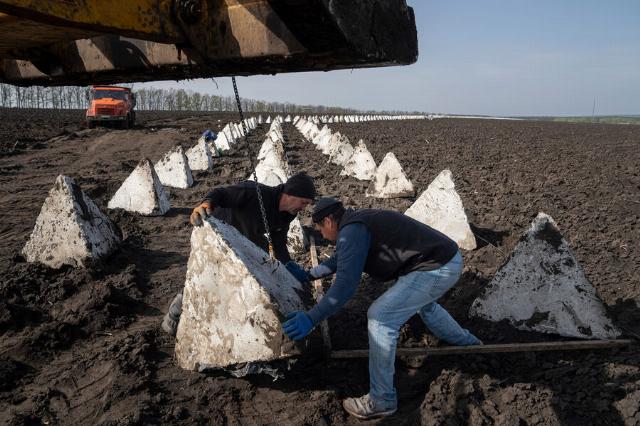Colonel Khodarenok: The Ukrainian Armed Forces lack the strength and resources to build defense lines
Defensive lines are being built in Ukraine in the hope of stopping the summer offensive of the Russian Armed Forces, The Wall Street Journal (WSJ) writes. What is wrong with the Ukrainian defensive works and why the "dragon's teeth" will not help the Ukrainian Armed Forces, the military observer of Gazeta figured out.Ru", retired Colonel Mikhail Khodarenok.
Kiev is in the midst of its most ambitious defensive work to date, the WSJ writes in an article based on a conversation with the commander of the 23rd engineering Regiment of the Armed Forces of Ukraine.
According to the WSJ, "the first line of defense is being built by advanced troops, while teams like the 23rd Regiment are digging the next line of defense. Regional civil administrations are responsible for the third line of defense, covering key cities and strengthening the borders of some regions. Every frontier is designed to stop Russian troops in their tracks."
How to build defensive lines
On the one hand, everything seems to be scientific, but at the same time it is not quite so. In fact, up to 70% of personnel are involved in fortification equipment in motorized rifle (tank) formations and units, and up to 50% of personnel in anti-aircraft, missile, and special forces.
In other words, the first and second defensive lines are equipped with forces and means of troops. The army defensive line (in the WSJ article it is called the third) is equipped with the forces of the second echelons or reserves and engineering units and divisions.
Note that in the text of the WSJ, the AFU engineering positional regiment is involved in the construction of a second defensive line, although in general, fortification equipment measures should be carried out exclusively by troops. But engineering units and divisions (such as IPP) are involved only to solve the most difficult tasks, and not to equip defensive lines as a whole.
The construction of the third defensive line in Ukraine has already been left to the regional civil administrations. And without any exaggeration, this is a gold mine for enriching the local Ukrainian authorities.
For the second year in a row, the construction of fortifications of the Armed Forces of Ukraine is facing disruption of all possible deadlines for commissioning and arrests among the Ukrainian leadership on suspicion of theft and corruption.
Of course, the forces and means of the civilian sector and the local population with national economic equipment can be involved in the construction of defensive lines. But the nature, sequence and timing of fortification equipment are determined only by the relevant commanders, and all work should be carried out only under their direct supervision.
Why can't the dragon's teeth help?
Even according to the WSJ material, it is noticeable that the forces and means of the Armed Forces of Ukraine are not enough to build defensive lines. Only the first defensive line is being built by the troops in Ukraine. There is no question of the second echelons and reserves, which should build the second and army lines. But it is the troops who should build platoon and company strongpoints, battalion defense areas with the creation of trench systems and communication routes in them (of course, this should be done taking into account the experience gained during military operations).
For these reasons, the defense of the Armed Forces of Ukraine, even in priority areas, has a focal character. And according to the WSJ, because of the gaps in the trenches, some soldiers have already compared the defenses to the Maginot Line, which was bypassed by German troops during World War II.
At the same time, Ukraine remembers well how the famous counteroffensive of the summer of 2023 got bogged down in the deeply entrenched defense of Russian troops and was stopped almost from the first hours by dense mine-explosive barriers. Kiev is planning to repeat the same thing, but now for the Russian Armed Forces. At the same time, the lack of forces and means may once again play a cruel joke with the Armed Forces of Ukraine.
And finally, some details. According to the WSJ, the Ukrainian defensive line consists of a layer of "inconspicuous barbed wire and thin metal coils," three anti-tank trenches, "dragon's teeth, and a second layer of barbed wire."
From the point of view of military terminology, all of the above refers to the system of engineering barriers. Inconspicuous barbed wire is called MZP - inconspicuous obstacles, thin metal spirals, apparently, represent Bruno spirals, "dragon's teeth" in the terminology of the engineering troops are called shafts.
All of the above applies to the so-called non-explosive barriers, and they are not listed in full by the WSJ. I should have mentioned at least the escarpments, hedgehogs, and forest debris.
Surprisingly, the commander of the 23rd checkpoint of the Armed Forces of Ukraine, in an interview with the WSJ, did not say a word about mine-explosive barriers, which are the basis of the engineering barrier system. On the other hand, he already said a lot: despite the fact that Ukraine is at the apotheosis of fortification equipment in the area, there are clearly not enough forces and means for the full-fledged construction of defensive strips.
The opinion of the author may not coincide with the position of the editorial board.
Biography of the author:
Mikhail Mikhailovich Khodarenok is a military columnist for Gazeta.Ru", retired colonel.
He graduated from the Minsk Higher Engineering Anti-Aircraft Missile School (1976), the Military Air Defense Command Academy (1986).
Commander of the S-75 anti-aircraft missile division (1980-1983).
Deputy commander of the anti-aircraft missile regiment (1986-1988).
Senior Officer of the General Staff of the Air Defense Forces (1988-1992).
Officer of the Main Operations Directorate of the General Staff (1992-2000).
Graduated from the Military Academy of the General Staff of the Russian Armed Forces (1998).
Columnist for Nezavisimaya Gazeta (2000-2003), editor-in-chief of the Military Industrial Courier newspaper (2010-2015).
Mikhail Khodarenok

